#east african lion
Text
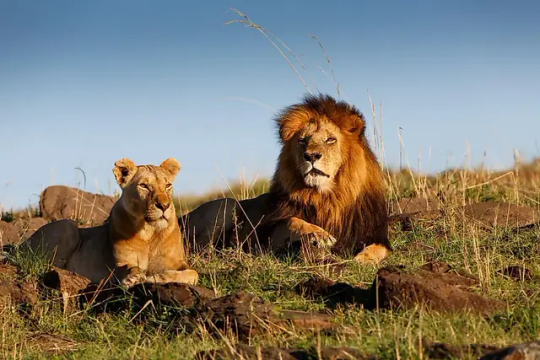



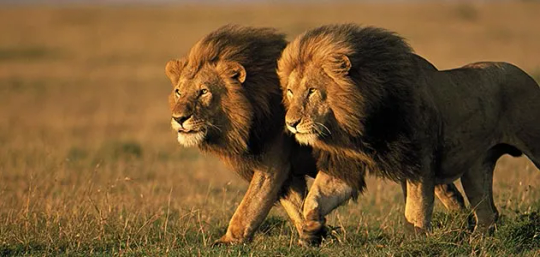
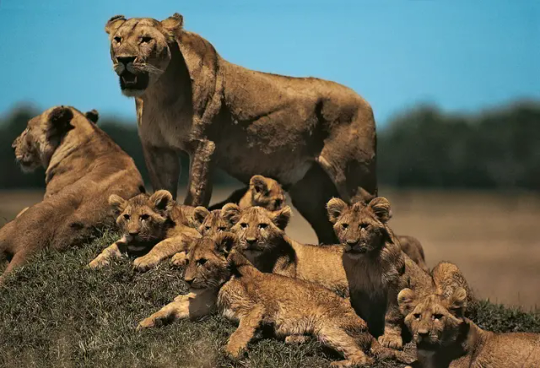



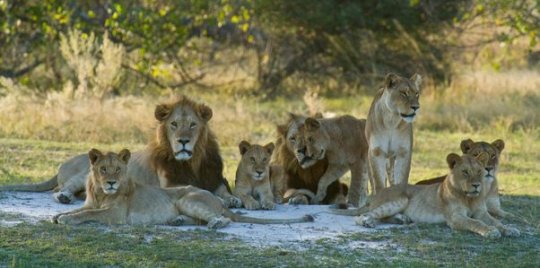
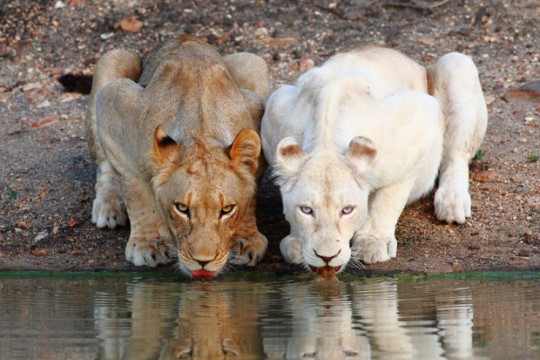
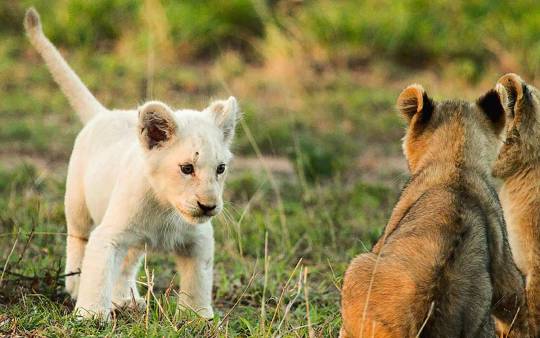
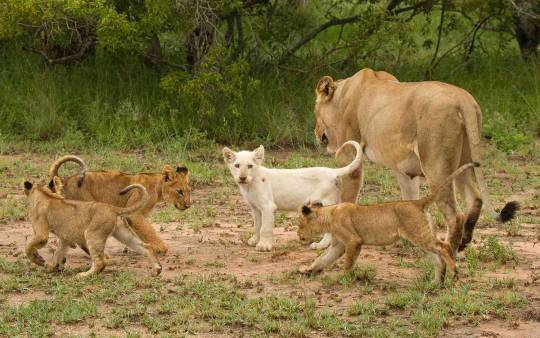
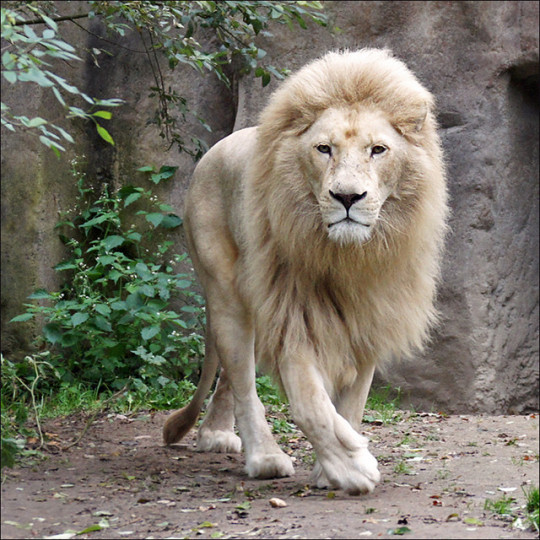
Panthera leo melanochaita better known as the east African lion, the Southern lion, the Southern African lion, or the East-Southern African lion,, is a subspecies of lion native to eastern and southern Africa. Here they prefer to inhabit grasslands and savannas, but are also known to inhabit open woodland, scrublands, and montane forests. African lions are the most social of all wild felines, living in groups of related individuals and their offspring called prides which number 3 to 30 females and 1 to 4 males. East African lions typically prey upon ungulates such as wildebeest, cape buffalo, eland, gemsbok, nyala, roan and sable antelope, warthogs, bush pigs, zebra, tsessebe, waterbuck, kudu, hartebeest, kob, and thomson’s gazelle, however they are also known to hunt other prey from as small as common mice to as large as young or infirm African bush elephants. Lions are themselves occasionally killed by other predators such as wild dogs, hyenas, leopards, other lions, and crocodiles. Female east African lions average around 7.5 to 8.9ft (2.3 to 2.7m) in length, and 183 to 370lbs (83 to 168kgs) in weight while males average around 8.1 to 9.4ft (2.47 to 2.84m) in length and 321 to 496lbs (145 to 225kgs) in weight, however lions as big as 11ft (3.35m) and 825lbs (375kgs) have been known to exist. This marks the lion as the second largest extant cat after the tiger. The lion is a muscular, broad-chested cat with a short, rounded head, a reduced neck, and round ears. The fur varies in color from light buff to silvery grey, yellowish red, and dark brown, additionally albino and leucistic individuals are not unheard of. Mature males typically sport long flowing manes, but may occasionally lack them. Additionally females may occasionally grown manes as well. Breeding may occur year round, with each mature female having there own estrous cycle. When in heat she will breed with one or more partners. After a 110 day pregnancy a mother lion will give birth to 1 to 4 cubs in a secluded den away from the rest of the pride. She will not rejoin the pride until her young are around 6 to 8 weeks of age. East African Lions reach maturity around 2 to 4 years of age, at which point the males are typically forcibly evicted from the pride and females may choose to set of in search of another to join. Under ideal conditions an east African lion may live up to 18 years.
#pleistocene pride#pleistocene#pliestocene pride#pliestocene#cenozoic#ice age#stone age#mammal#lion#africa#african lion#east african lion#white lion#cub#lioness#cat#big cats#feline
31 notes
·
View notes
Text

East African Lion in Mana Pools National Park, Zimbabwe
Birger Strahl
#Mana Pools National Park#Zimbabwe#National Park#Wildlife#ZimbabweWildlife#Africa#East African Lion#African Lion#Lions#Lion
0 notes
Text

Beisa Oryx by Louis A. Sargent. From Wild Beasts of the World, Vol. Two. Written by Frank Finn, published in 1909.
Internet Archive
#mammals#ungulates#antelope#oryx#east african oryx#felines#big cats#lions#predation#Louis A. Sargent
197 notes
·
View notes
Text
Vintage Kenya Lion Rampant Guardant Former Heraldic Crest 1920 to 1963 Silver & Enamel Travel Shield Charm by REU
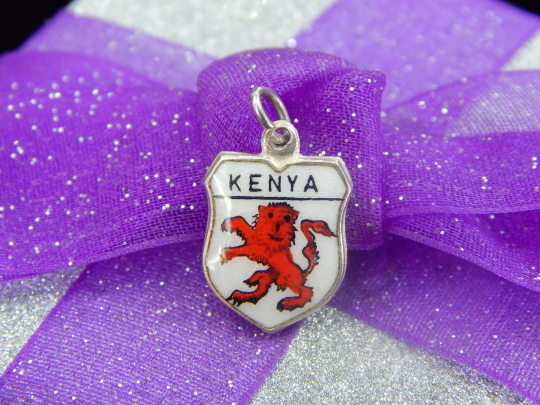
Wonderful silver travel shield charm with a red lion, depicted in profile standing erect with forepaws raised, is a symbol of courage, strength, and protection. This terrific travel shield will look terrific on your favorite charm bracelet or necklace!

#kenya#africa#african jewelry#african charm#travel charm#travel shield#vintage charms#travel#lion#lions#rampant#nairobi#east africa#east african#coat of arms#heraldry#kenyan#crest#crown colony#mombasa#british east africa#etsy
0 notes
Text
In the current epidemic of rich Western women who cannot “choose” to eat, we see the continuation of an older, poorer tradition of women’s relation to food. Modern Western female dieting descends from a long history. Women have always had to eat differently from men: less and worse. In Hellenistic Rome, reports classicist Sarah B. Pomeroy, boys were rationed sixteen measures of meal to twelve measures allotted to girls. In medieval France, according to historian John Boswell, women received two thirds of the grain allocated to men. Throughout history, when there is only so much to eat, women get little, or none: A common explanation among anthropologists for female infanticide is that food shortage provokes it. According to UN publications, where hunger goes, women meet it first: In Bangladesh and Botswana, female infants die more frequently than male, and girls are more often malnourished, because they are given smaller portions. In Turkey, India, Pakistan, North Africa, and the Middle East, men get the lion’s share of what food there is, regardless of women’s caloric needs. “It is not the caloric value of work which is represented in the patterns of food consumption” of men in relation to women in North Africa, “nor is it a question of physiological needs…. Rather these patterns tend to guarantee priority rights to the ‘important’ members of society, that is, adult men.” In Morocco, if women are guests, “they will swear they have eaten already” or that they are not hungry. “Small girls soon learn to offer their share to visitors, to refuse meat and deny hunger.” A North African woman described by anthropologist Vanessa Mahler assured her fellow diners that “she preferred bones to meat.” Men, however, Mahler reports, “are supposed to be exempt from facing scarcity which is shared out among women and children.”
“Third World countries provide examples of undernourished female and well-nourished male children, where what food there is goes to the boys of the family,” a UN report testifies. Two thirds of women in Asia, half of all women in Africa, and a sixth of Latin American women are anemic—through lack of food. Fifty percent more Nepali women than men go blind from lack of food. Cross-culturally, men receive hot meals, more protein, and the first helpings of a dish, while women eat the cooling leftovers, often having to use deceit and cunning to get enough to eat. “Moreover, what food they do receive is consistently less nutritious.”
This pattern is not restricted to the Third World: Most Western women alive today can recall versions of it at their mothers’ or grandmothers’ table: British miners’ wives eating the grease-soaked bread left over after their husbands had eaten the meat; Italian and Jewish wives taking the part of the bird no one else would want.
These patterns of behavior are standard in the affluent West today, perpetuated by the culture of female caloric self-deprivation. A generation ago, the justification for this traditional apportioning shifted: Women still went without, ate leftovers, hoarded food, used deceit to get it—but blamed themselves. Our mothers still exiled themselves from the family circle that was eating cake with silver cutlery off Wedgwood china, and we would come upon them in the kitchen, furtively devouring the remains. The traditional pattern was cloaked in modern shame, but otherwise changed little. Weight control became its rationale once natural inferiority went out of fashion.
— Naomi Wolf (1990) The Beauty Myth
#hunger#long post#naomi wolf#the beauty myth#radblr#radfem#radical feminism#radfem safe#radical feminist safe#!!!
734 notes
·
View notes
Text
Falling For You

Summary: Spencer is completely oblivious to how madly in love you are. That's it. Warnings: fluff and swearing.
A/N: I feel like this idea has been done before, so if I subconsciously copied a fic, let me know!! Also, I didn't mean to do it, but this story is technically spencerxgn!reader so. Also, i'm back!! Another story is coming out at 9pm EST, so be ready!!!
Word Count: 0.9k
Song Suggestions: Wildest Dreams (Taylor's Version) by Taylor Swift
You two clicked immediately. It was strange, you were both so opposite. I guess that's what made it work. What he lacked you made up for and reversed. Not many other people knew much about your personal life except for him. Your favourite thing about him was his words. Everytime he rambled about the most random times you could listen forever.
Whenever he looked at you, you melted. When he smiled your face burned from blushing. And whenever he talked you just wanted to kiss him. But you had no clue if he felt the same. For a genius he was quite oblivious to your flirting and comments. If he liked you he definitely had a good way of hiding it.
There was only one issue.
***
The movie was about halfway through and you made sure to turn the couch into a bed, Spencer had come over to watch it with you. If someone asked you tomorrow morning what the movie was about you wouldn't be able to say, he'd been talking the whole time.
"...That actually isn't correct," He started, moving his hands around for emphasis. "In the wild, there are two formally recognised lion subspecies. The African lion is found in Africa, south of the Sahara desert. The Asiatic lion exists in one small population around Gir Forest National Park in western India. Wild lions in the west and central Africa are more closely related to these Asiatic lions in India than to those found in southern and east Africa. So realistically the characters would be..."
Listening to him talk was like heaven, but at the same time it was hell. He just looked so huggable.
No, kissable. The butterflies in your stomach made you giggle, he paused and frowned. Looking like a lost puppy.
"What? Did I say something wrong?" Stumbling over the words as he spoke, you stopped laughing and grabbed his hands while smiling.
"No, no you didn't. It was just…cute." You muttered.
"Thank you?" A confused look on his face when he responded. Your heart shattered a little, that was obvious wasn't it? Did his feelings not reciprocate? "Oh! Also, manes on male lions tell a story. Male lions grow impressive manes the older they get. These manes grow up to 16 cm long and are a sign of dominance. The older they get, the darker their manes go. As well as attracting females, their manes may also protect…"
His words trailed off again and he stared at you. "You keep being weird. You're all red. Did I say something wrong? I know that sometimes I speak for too long and I go on and on, which annoys people-" He sighed, "And I'm doing it now. I'm sorry."
"No, please. I love when you talk. It's calming." Grinning, you continued, "So what about protection?"
"Oh, um…manes can also protect their neck and head from injuries during a fight." He slowed down his speaking, like he was a little self-conscious about his words now. When he stopped talking everything was silent, except for the sound of the movie quietly playing on the TV in front of you.
"Spence? What's wrong?" Tilting your head and looking at him, he was staring at the TV but he didn't seem to be watching it. Just thinking, his eyebrows furrowed like they normally did while he was deep in thought. "What are you thinking about?"
"Have you been flirting with me?" He blurted out, looking back up and at you. You almost jumped, not expecting that question.
"What?" Still in shock it took you a minute to respond. Letting the silence fill the air again, he didn't speak. He just stared, waiting for an answer. "I-What would you think if I was?"
"I would've wished I'd noticed sooner." He sighed, making that puppy-dog face you loved. Neither of you really knew what to do and sat there for what you would believe could've been hours.
"Fuck it." You breathed out and as if he knew what you were thinking as well he leaned in at the same time as you, kissing you softly. After a couple seconds you felt his hands wrap around your face, holding it as he kissed more.
Your hands didn't know where to go, after a couple more seconds they finally found their place, one around the back of his neck and the other tucked around his waist. Pulling you closer to him.
A couple seconds later you both moved away from each other, only long enough to catch your breaths and muttering random words. Before you knew it the both of you were back to kissing, to make up for how long you guys spent not kissing.
The longer it went the closer to each other you got, his one hand started to slide down your neck and then your waist when suddenly your hand hit a button and the movie that was still playing turned up to full volume.
Both scrambling for the remote he managed to shut the TV off, surrounding you both in the darkness of the night.
The two of you continued to kiss every once in a while but it didn't take long for the darkness to make you both sleepy and you ended up just cuddling. You fell asleep with your head on his chest, listening to his heart beat. He had one hand holding you close to him, as if someone was coming to steal you away. The other hand tracing up and down your back until he too, drifted off to sleep.
#criminal minds#spencer reid#criminal minds fandom#fandom#fanfic#bau#spencer reid x reader#spencer reid x you#spencer reid x gn!reader#sofiareidings
502 notes
·
View notes
Text
homecoming (I)
pairing: leona kingscholar x fem!reader
warnings: slight angst, allusions to childhood mistreatment
word count: 1.5k
s: at your insistence, you finally visit the afterglow savannah and meet Leona's family
a/n: this was written before the tamashna muina event released. and since I haven't read the trans yet, how I describe the savannah and its culture may not be the same as it was described in game. I'm East African, and since the lion king was essentially a mishmash of East African culture (mostly Kenya, Ethiopia, and for some reason some stuff from W. Africa), most of what I describe comes from my own cultural background + light research. enjoy!

It starts with a letter.
It’s not unusual for Night Raven College to be overrun by its unruly student body, but the coming summer holiday brings a new level of restlessness that hums through the walls. Hasty stops at the school store, last minute assignments, bittersweet goodbyes. Even the faculty seem on edge and ready to end the semester.
Ruggie all but collapses at your feet when he spots you in the hall of mirrors, heaving a woven basket twice his size. It’s filled to the brim with an assortment of different packages; mailers, bags, miniature boxes wrapped in newspaper clippings and assorted wrapping paper. A neat ivory envelope tied with a golden ribbon at the very top.
He gives it to you. “Could you hand this off to Leona? I have enough on my plate as it is.”
“Is it usually this bad?” You ask, eyeing the precarious stack that’s leaning just a little too close to the floor. You turn the envelope in your hands. The words on the front are written in a script you can’t make out, only recognizing ‘Leona Kingscholar’ in the far left corner. It’s bulky, like someone crammed multiple letters inside, but doesn’t take away the luxurious quality of the paper. It’s silk between your fingertips.
“It’s from his family, so I doubt he’d read it anyways,” Ruggie comments. He hefts the basket from the floor, “Throw it out if you want.”
His family.
Besides bitter remarks thrown in passing, Leona never speaks of them. Or his home. What you’re holding in your hands is the only piece of the other Kingscholar’s you’ve ever gotten so close to. The letter is tucked away before you give the suggestion a second thought.
“You came all this way, I might as well.”
“You just wanna read it, huh?”
“And you wouldn’t?”
Ruggie laughs at that, turning to the door with a shake of his head. “There’s a reason curiosity killed the cat. Something’s I’d rather not know.”
______________________________________________________________________________
“Took you long enough.”
Warm arms circle your waist as you enter the room, dragging you backwards until you hit the plushness of his sheets. He’s practically on top of you. Flush against him, back to chest. His head finds its way to the crook of your neck and you can feel the sigh he releases on the wisps of your hair. The softness of his tail curling around your ankle.
Leona’s tone is scalding, but the delicate possessiveness of his actions tell you otherwise.
You turn your head. Heavy olive irises sharpen as you place the letter between the both of you. “I got caught up.”
Groaning, he’s quick to toss it on the nightstand before burrowing himself further into your neck. With you two so close, sheets ballooned around you, a drowsy warmth fills you. It’s hard not to fall into it.
“That’s the last thing I need right now.” He huffs.
You raise a brow. “You haven’t even read it.”
“Doesn’t matter. It’s the same old shtick. Naggin’ me to come for break.”
He sighs. “If it was up to me I’d just stay here.”
“Aw, you’d miss me that much?” You tease, yelping as he pinches your side. The laugh pulled from his lips ease into a yawn.
“In your dreams.” Leona exhales. His breath evens out, warm against the shell of your ear as he’s lulled into sleep.
And that was that.
In your position on the bed, you have a perfect view of the nightstand, eyes catching the glimmer of gold ribbon in the dim light.
Coming to Twisted Wonderland, you’ve constantly been thrusted into the most asinine of situations all while being told to keep your head down and leave things where they lie.
But you're a curious sort by nature. It’s a hunger, insatiable in its pursuit to pick everything apart, examine every crack and rough edge, feel the grain against the pad of your fingers, piece by piece. You’ve disrupted the debased philosophies of Night Raven College’s elite because you’re always pushing for more, not settling for less.
This is not something you are ashamed of.
Yet, as you stare at the envelope in front of you, you can’t help but feel hesitant.
Leona is an enigma, an ever changing labyrinth. The moment you think you have him figured out, the layout changes and you’re back at square one. And it leaves you starved.
You want to know him, yearn to trace his patterns like the dips in the back of your hand; know where each curve started, why it ends, and swallow it whole to keep wherever you go.
You also know this: if you push too far Leona will close himself away and never let you see these parts of him ever again. And you’ve grown greedy.
(Something’s I’d rather not know)
You grab the envelope.
The ribbon gives easily enough, and you’re met with letter after letter, all scrawled in messy print. You realize these were written by Cheka– asking his uncle how he’s doing, when he’s coming to visit, and what he’s been up to at the palace since the last time Leona saw him. On the bottom of some of the pages were crayon drawings: portraits of his parents and scenes of Leona and him together, exploring the palace or traveling through the city.
As you sift through, a paper falls into your lap.
It’s a photograph of Cheka and who you’d assume to be his parents. The man in the photo is laughing, light smile lines gracing his face. Cheka’s in his arms, and the woman beside them looks at the sight with fondness. The background is flooded with the country’s namesake- an assortment of orange, yellow, and pinks kaleidoscopes together in a painting of the setting sun. It looks homey, tender and inviting, and you can’t help the smile that curls around your lips.
You’d love to be there, surrounded in that warmth.
Leona’s scoff makes you jump, looking over at him, and his bleary eyes meet your stare. His expression was mostly hidden in the depth of your shoulder but he didn’t look pleased. You didn’t realize you said the words aloud, or that your movements woke him.
“Go be a comedian if you wanna start telling jokes.” He grunts. You turn yourself in his grasp to face him fully and his arms tighten their hold. His hair is mused with sleep, blanketing the pillows beneath. Your hands itch to touch it.
“I don’t think it’s a bad idea,” You insisted. He scowls at this, tail shifting back and forth beneath the sheets. “ I want to see the Afterglow Savannah, the palace, your family. It'd be nice to know where you grew up.”
The message is quiet. You do not tell me enough.
Leona grows silent. Contemplative. He knows when you get like this, stuck on an idea that overrules your every action, close to nothing can convince you otherwise.
He told you once that’s a trait he liked about you in the best of times.
( ‘But half the time it just makes you hard headed’ he said, and snickered at your glare.)
Leona knows you well, too well. Usually this would bring a coy flush to your face, but you couldn’t help but grimace at the thought.
“I just want to know more about you.” You admit.
“You could just ask.”
“Like you’d tell me.”
He says nothing, looking through you, deep in thought. Leona doesn’t seem annoyed by your probing, but something about the furrow in his brows looks resigned. Bitter.
“There’s nothing worth seeing.” He bites out. “It’s a bunch of royals too stuck up to see past their ivory towers.”
The photo; the honest smiles and laughter.
“I’m sure there’s more than that.” You contend.
Something bubbles forth in him. A dark quality you haven't seen before. He growls deep in his throat. It’s too low for your ears to catch, but you feel it reverberate through the bed and into your chest.
“ Yeah, the stupid age old rules they hide behind–and they're sure to ostracize anyone who steps outside it.” He meets your gaze.“Birth order is the only thing that matters. If you’re not first then you’re nothing.”
The vitriol in his tone catches you off guard, and the words fall away from your mouth before you can stop yourself.
“Do you hate the Afterglow Savannah?”
Instead of the eruption of anger you expected, the brewing storm leaves him sullen.
You regret it as soon as it passed through your lips
“You really don’t let up do you?” He sighs. Leona’s voice is oddly gentle. You wait for the other shoe to drop; anger, arrogance–anything. But it never comes. His arms move you so you’re in your original position, back to chest, as if the conversation never happened. Except this time, he curls himself into you– his body hiding you away, swallowing you whole.
“Stop worrying about it.” He mumbles. “Hurry up and sleep.”
You don’t. You spend that afternoon staring at the photo, tracing over their juvenile smiles.
Leona’s was not one of them.

TBC
#twst#leona kingscholar#leona kingscholar x reader#twisted wonderland#twst x reader#reggie buchi#twisted wonderland x reader#leona#leona x reader#leona x you#rip to ruggie as I always put him in the middle of these two
268 notes
·
View notes
Text
In a study published in the journal Science, a team of scientists report that a tiny and seemingly innocuous invasive ant species is changing tree cover in an East African wildlife area, making it harder for lions, the world's most iconic predator, to hunt its preferred prey, zebra.
"These tiny invaders are cryptically pulling on the ties that bind an African ecosystem together, determining who is eaten and where," said Todd Palmer, an ecologist and professor in the Department of Biology at the University of Florida.
Continue Reading.
104 notes
·
View notes
Text

[ A jar in the shape of an ibex, retaining one natural horn, found in the tomb of the pharaoh Tutankhamun. Photographed by Robert Harding. ]
"Millennia ago, northern Africa was much wetter and cooler. Monsoons struck periodically, and the Sahara was covered with lakes and vegetation. This greener version of Egypt was home to a mix of wildlife more like the one now found in East Africa, with 37 species of large mammals including lions, wildebeest, warthogs and spotted hyenas.
The region began to dry out about 5,000 years ago, a time that coincides with the fall of the Uruk Kingdom in Mesopotamia (located in present-day Iraq) and the rise of the pharaohs in Egypt. The Egyptian people at this time switched from a mobile, pastoral life to one of agriculture and subsistence hunting. The new research shows that several species of antelope, along with giraffes and rhinoceroses, disappeared around the same time—extinctions that could be due to overhunting of herbivores. Shortly afterward, the long-maned lion vanished.
Egypt became even drier around 4,200 years ago, during a time known as the “First Intermediate Period” or the “dark period.” The region depended on yearly flooding of the Nile to inundate the land and leave behind nutrient-laden silt to feed agricultural fields. But during the dark period, this flooding became inconsistent, crop yields dropped and famine ensued. War and chaos reigned, and eventually the Old Kingdom—and with it, the “Age of the Pyramids”—ended. This is when the roan antelope and African wild dog disappeared from the records.
A third aridification event occurred about 3,000 years ago, again bringing drought and an end to the New Kingdom, a time that included Tutankhamun and 12 kings named Ramses. Egypt’s short-maned lions, revered as sacred and even occasionally mummified, vanished around this time.
Then about 150 years ago, as Egypt’s growing population became more industrialized, more species disappeared, including leopards and wild boar. Today, only 8 of the original 37 large-bodied mammals remain."
- Excerpt from "Egypt’s Mammal Extinctions Tracked Through 6,000 Years of Art" by Sarah Zielinski.
115 notes
·
View notes
Text
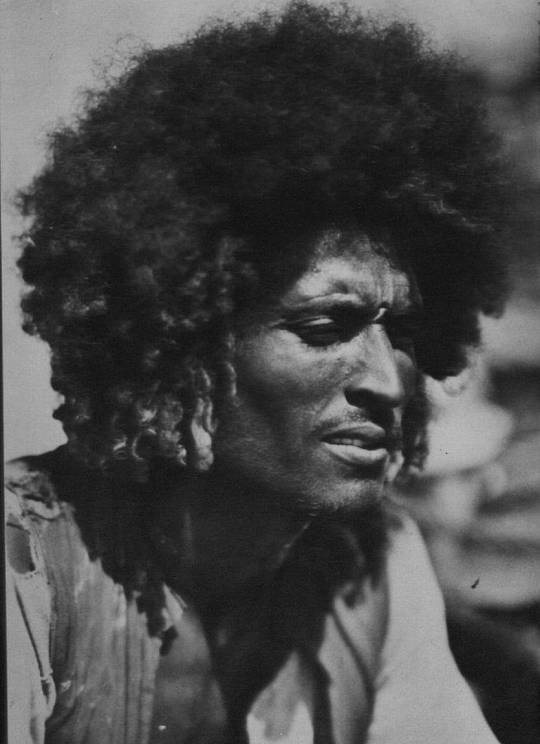


Hadandawa East sudan-" الهدندوة "The name Hadendowa is said to come from hada (lion) and (n)dewa (clan). ( the lion Clan) .
I think they have Routes from East African trips they have mixed cultures
#sudanese#sudan#السودان#photography#vintage#vintage sudan#sudanese culture#photograph#sudan archives#east sudan#east africa#الهدندوة#African
69 notes
·
View notes
Note
A bit of an out of the blue question but do you think the new event outfits are offensive or innacurate in any way?
I saw some people have started using this, Cater's New Year's outfit and Diasomnia's dorm uniform as an example of why Twisted Wonderland and Yana Toboso are offensive.
Note: I am not saying Twisted Wonderland is an offensive game in the slightest but I've seen a lot of people have issues with certain things in the game they find problematic.

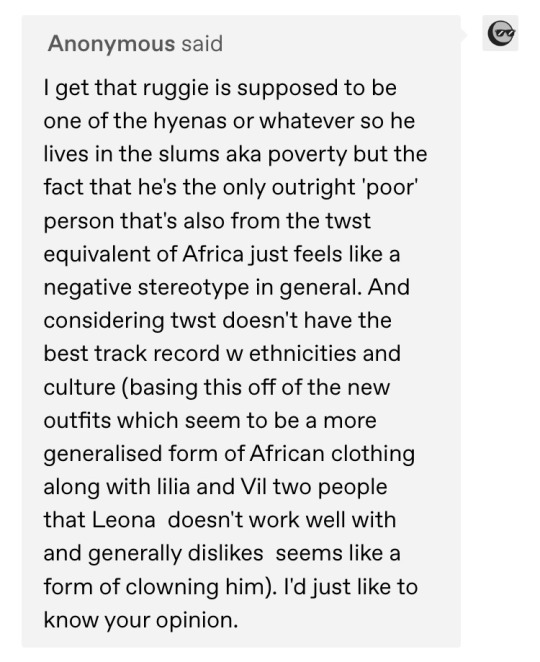
[Referencing this post!]
Okay, so 💦 we’re going to get into a lot of heavy topics about real world events and cultures in this post, so please take note of the tags and content warnings before proceeding!
I also want to preface this with the disclaimer that I do not intend to speak on behalf of the groups affected by this, nor am I am an expert in matters of world history/various cultures. I am only presenting you with the preliminary knowledge that I have so that you can come to your own conclusions.
I will, of course, give my own thoughts on these situations, but please bear in mind that it shouldn’t be my responsibility or obligation to do the research for you or to tell you right from wrong; that’s a decision you need to learn to make for yourself.
***CONTENT WARNING: discussion/mentions of war, racism, colonialism, Nazism, orientalism, genocide, and imperialism!***

To make things easier for everyone (including myself), I’m going to begin with responding to the latter 2 asks above.
I will then address the immediately relevant topics regarding the clothing in the Sunset Savanna event, then work backwards chronologically (so the section after is about Cater’s New Year clothing, and the final section is about the Diasomnia uniforms). I will have my general thoughts at the very end of each section, and then my overall thoughts.
On “Orientalism”
To the second ask's Anon 💦 I believe you’re not using that term correctly. “Orientalism” refers to appropriating or condensing elements of specifically Asian cultures (which includes the Middle East), not African cultures. By definition, the outfits of the Sunset Savanna are not “orientalist” because the clothing is meant to draw inspiration from African sources, not Asian ones. "Orientalist" is not a synonym for the word "racist", but rather orientalism can be an example or a component of racism. Please be more careful with your wording.
On Ruggie and the “African Poverty” Stereotype
This part is to address the Anon in the third ask!
I don't believe that Ruggie is a stereotype of African poverty. It can appear that way because we have such a small sample size of students from the Sunset Savanna (3). In statistics, the conclusions drawn are significantly less reliable or accurate if you're pulling from a small pool of data. I think this is also the case with Ruggie. It's an example of representation bias, where seeing one extreme makes an observer assume that this extreme says something about the whole group without looking at other context clues. Even if we were to accept that comparing Ruggie to the other two Sunset Savanna students is an acceptable measure, the stereotype still doesn't hold. Neither Leona nor Rook are destitute, which would seem to imply that Ruggie's impoverishment isn't the norm in their country, but an outlier. Even other minor mentions of characters from the Sunset Savanna do not imply poverty (ie Sebek's grandfather, who is said to come from there).
Secondly, I think that Ruggie being the only "poor" character in the main cast is a conscious decision, but not one made from racist roots. Each of the TWST characters borrows heavily from their respective Disney counterparts, and as you've stated yourself, the impoverished background that Ruggie comes from harkens back to the struggle of the hyenas in The Lion King. This is different from the other six movies whose villainous characters are twisted, as they largely do not have circumstances which focus on socioeconomic class differences. The closest other example we get to that is Aladdin, but this doesn't hold up since we don't have a formal twisted!Aladdin with which to contrast to Kalim's enormous wealth. Jamil is twisted from Jafar, who is the Sultan's advisor, and thus would have a great amount of wealth himself (hence why this is reflected in Jamil by having the Viper family also be fairly well-off). This means that Ruggie was very deliberately designed to be the way he is because of his Disney inspiration. It's a large part of his character, right down to several lines he speaks in episode 2--all that talk about how even hyenas can "become king" at NRC.
Regarding NRC, we need to remember that it is considered a VERY exclusive private school. If it’s anything like upscale learning institutions in the real world, most of the students attending will be from wealthy/influential families or just middle class or upper middle class ones in general. Look at how stacked the NRC cast is; Riddle’s parents are healers (his mom being very highly respected), Leona and Malleus are royalty, Vil is a huge celebrity, Cater’s dad is a banker, Rook and the twins are implied to be from important families, Idia is the future director of a secret organization, Kalim is loaded, etc. It makes sense that there would be far fewer impoverished students compared to privileged ones (though I do think it’s unfair 😔).
Another thing to consider is that while Ruggie is definitely the most extreme case of poverty in the main cast (again, due to being twisted from the hyenas), there are others in less-than-ideal situations too. We cannot discount them in this discussion. Deuce is from a single parent household (which most likely means a smaller income than a two parent household), and it is implied in episode 5 that Epel’s entire village was struggling financially until Vil stepped in. Poverty is a spectrum, and we see this in lesser forms in the other students. As you’ll notice, even when we count Deuce and Epel, “poverty” is a small fraction of the main cast, which, again, is similar to patterns observed in real world posh private schools.
The final point I will make here is concerning Lilia and Vil. Yes, they’re unorthodox picks for a Sunset Savanna event, but this doesn’t mean there is ill intent behind them going. We can’t say “it feels like the devs made this decision to clown Leona” because the event is not out yet and therefore has not had an opportunity to explain why those two specifically joined the group for the trip. I don’t even think it’s particularly weird to see Lilia and Vil traveling in general; it seems like they do that a lot anyway (Lilia has canonically traveled a lot and Vil has traveled with his dad and must travel sometimes for his job). Leona also appears to dislike a majority of the main cast, not just Lilia and Vil; if anyone else had been picked, he’d probably be just as grumpy about it. (Leona probably doesn’t like that Kalim is coming along either; why is the hate presumed to be directed only at Lilia and Vil?) It’s grossly preemptive to make conclusions about the reasons why Lilia and Vil are present and how Leona feels about them going with him before the event has come out 💦
Sunset Savanna Clothing
While coding certainly exists (ie when fictional things are stand-ins for real world people, objects, concepts, places, etc), fiction is also able to draw on real world inspiration WITHOUT being a one-to-one parallel of the real world AND without necessarily being racist. This is true of media such as Avatar the Last Airbender, which exposits many eastern philosophies and concepts, such as balance with nature, balance, and destiny, while also having designs and a world heavily inspired by a number of Asian groups. Although it is clear that each of the four elements has a main inspiration (the Air Nomads draw from Tibetan monks, the Water Tribes draw from the Innuit people, the Fire Nation draw from Japan, and the Earth Kingdom draws from China), these are not absolutes. For example, Song, a healer from the Earth Kingdom (based on China), wears a hanbok, a piece of clothing which is traditionally Korean. Avatar intersperses ideas from many Asian cultures in a thoughtful manner because these are just parts of their world WITHOUT ever claiming to be “Chinese” or representative of Chinese. These real-world concepts and ideas were appropriately adapted for a fictional world, and it is not appropriation because it is not done in an exploitative or disrespectful manner.
I would argue that Twisted Wonderland is capable of doing the same, as we’ve seen places such as the City of Flowers (which is basically twisted Paris without explicitly BEING “just Paris but with magic”). You can tell from the food and the language spoken that the City of Flowers IS meant to be “French”, but they have a customs and traditions of their own that isn’t tied to real world Paris. Twisted Wonderland is never claiming that “oh, this fictional country is supposed to be a version of [this country in the real world]”; they are adopting ideas and making them into new lore for their own world. This is also true of other areas we have visited like Harveston and the Scalding Sands. The only reason conclusions are drawn that parts of the TWST world are “equivalents” to those on our world comes purely from fandom speculation and interpretations.
Some will think that the TWST world should be exact representations of the real world, and others choose to make the divide between fiction inspired by reality and reality itself. This distinction is important to consider in navigating this conversation, as the stance adopted will definitely play into whether one believes content to be in poor taste or not.
Yana herself has stated that the Sunset Savanna event has been in the works for 2 years now, so I’d imagine that a considerable amount of research and planning went into this event. I won’t speak on the quality of said research, as we can never know for sure. However, if previous homestay events are of any indication, the research was most likely NOT to make a one-on-one 100% “accurate” recreation of any African culture but rather to integrate elements of African culture to create a part of the TWST world which can exist as its own entity while still remaining respectful of its inspiration. We must also remember that the event itself isn’t out yet, so we can’t accurately judge if there is appropriation or offensive use of its inspiration with just some visuals. A similar situation happened when Rollo was first announced and we hadn’t even met him in the game yet; people jumped the gun and claimed that because the character he is inspired from is racist and genocidal that Rollo too is problematic—yet when the story actually unfolded, Rollo was not either of those things. He still borrowed ideas of self-righteousness and contempt for sinners (magic users in this context) from his Disney counterpart, but he was not the exact same as that counterpart.
With that being said, let’s talk about the new event outfits. The question on the table is “are these clothes offensive or inaccurate in any way?”
Firstly, is important to understand that Africa is NOT a monolith. It would be impossible (and frankly reductive) to boil down a whole continent to a single unified style of dress. Gauging the “accuracy” is simply something that cannot be done, as it appears that Twisted Wonderland borrowed from many areas of Africa when designing the looks. It wouldn’t be 100% accurate to any singular part of Africa, just as Avatar would not be 100% accurate to any singular part of Asia.
Secondly, we cannot speak for others or over others. If you want to know if the clothes are offensive, ask an African or someone who can speak wisely on the matter. It’s not that others cannot hold an opinion on it, but I think it's just as valid, if not moreso, to hear from the ones whose cultures are being represented rather than just the people who claim to speak for or defend those cultures while not being a part of it. Someone with knowledge of and experience of a certain culture can speak for themselves and how they feel about this. They just may choose not to, especially in the cases where they aren't deeply upset with the representation (because if they don't feel a strong emotion toward it, what is there for them to react to publicly?). The spectrum of hurt is also vital to consider here. When we focus only on the loudest voices (no matter where it may come from), it creates this false assumption that more people are upset than there actually are, or that one/a handful of comments reflects the thoughts of the entire group.
I personally don’t find the clothing offensive, but take my opinion with a grain of salt, as I’m not super familiar with African fashion. (I’m not counting a few Google searches as enlightening me on the full extent of it.) From my understanding, the outfits seem to borrow heavily from the designs of The Lion King’s Broadway musical and even Black Panther (two Disney productions that have been positively received by at least the African American community). I see a lot of similar patterns and accessories in Leona and crew’s outfits; my thought is that if the latter two pieces of media also borrow from many different African cultures and were not widely criticized for inaccurate or offensive portrayals of their costuming, then what is the issue with TWST’s? No one in any of these productions (TWST included) is claiming to be presenting Africa as a monolith but rather is borrowing elements from many countries, tribes, and even other cultures entirely to come up with their costumes. Again though, I wouldn’t take my word as gospel; please look around the community and see if there are any African fans that do take offense to the design direction that TWST has taken. (If anyone that is familiar with African fashion and/or culture does see this post, I'd love to hear your thoughts and broaden my understanding of this situation.)
In saying that, I also want to stress that you aren’t “wrong” or “bad” if you disagree with this take. I do not mean to discredit or to invalidate people’s thoughts on this matter; I understand why people feel so strongly about this, especially when popular media has historically not been kind or accurate in its depictions of other cultures. When a pattern has already been established, it’s so much easier to be wart of new content. You have a right to find whatever material you encounter as offensive or not offensive; all ask is that you respect differences in opinion, and at least give the event a chance rather than letting your thoughts prime (set expectations for) the perception of every bit of lore to come in the new event 💦
Cater’s New Year Outfit
The issue that people take with Cater’s outfit is associated with the particular design of it, which is very reminiscent of the style that was worn and popularized during the Taisho era of Japan. For those who may not know, the Taisho era is not remembered fondly because it is characterized by Japanese imperialism into significant parts of Asia, such as China, Korea, and Taiwan. There’s more grueling history there, but I’m going to cut it short for the sake of brevity. You’re free to do more research into this if you’re interested.
For comparison, here is Cater's New Year attire and here are some examples of Taisho era clothing:

As you can see from the linked images, Cater has some elements of Taisho clothing while also sporting a modern twist to them. The cut of his shirt imitates the cut of the nagajuban, and instead of an obi, he wears his usual Heartslabyul sash at the waist. Additionally, it can be argued that the Heartslabyul jacket worn over that is meant to be similar to the cloaks characteristic of Taisho fashion.
In any case, what I said for the Sunset Savanna clothing also applies here; please listen to the voices of people who were impacted by Japanese imperialism. Their feelings are valid, and if they find discomfort in Cater wearing the clothing, then those feeling should be respected. However, individual opinions will widely vary and are not representative of the entire group. If one Chinese person says they are offended by Taisho clothing, it doesn’t mean ALL Chinese people will find it offensive.
At the same time, someone is NOT automatically a bad person or supportive of imperialism just because they enjoy the fashion or excuse Cater for wearing it. Some will believe that clothing is just clothing and that there isn’t a deeper message behind it unless the one wearing that clothing acts in a way that glorifies what they wear. And indeed, it is possible to appreciate the fashion of a time period without condoning the things that occurred or were promoted during that same time period. For example, if someone were to wear Edwardian inspired fashion or just straight up Edwardian era clothing, it doesn’t mean the individual supports colonization. Clothing CAN be used to project a message, but it does not ALWAYS project a message.
This is actually something I feel I can speak on, as my family comes from one of the areas directly impacted by Japanese imperialism. I don’t personally take offense to Cater wearing what he is. I’m of the opinion that so long as he’s not acting in a way that glorifies imperialism then it’s fine; to me, wearing it alone does not promote imperialism, just as “problematic” material appearing in media does NOT mean automatic support of that material). That being said, I also have friends with similar backgrounds that are offended by Cater’s clothing. We are able to disagree without acting morally superior to one another or insulting the other’s views, and I feel that this is something that should extend to others when discussing this topic. At the end of the day, we must accept that one opinion does not define a whole country and that there is no clear “right” answer here; it’s all left to individual interpretation.
Diasomnia Dorm Uniforms
I’ve already previously addressed the Diasomnia uniform controversy here.
To quickly summarize, it appears to have been a mistranslation of a particular term; this most likely occurred due to the context of the rest of the sentence not being taken into account when translating. OP’s translation has since been deleted, but the Reddit thread of responses still exists and in it, OP apologizes for this error.
Personally, I don’t see a point in assuming the worst of people when the context clues all point to it being a translation error and not purposefully meant to invoke imagery of N*zis. To me, it looks like a general military look with some elements of equestrian fashion and nothing more than that. As is the case with Cater’s New Year attire, I have friends who think otherwise. While they concede that there was a mistranslation, they still perceive the Diasomnia uniforms as questionable in design. These opinions can coexist, because everyone’s perceptions will vastly differ based on their own world knowledge and experiences.
I want to reiterate a point I bring up in the Diasomnia post, as it relates to “problematic” or sensitive content in general:
[...] we should not make assumptions in such broad strokes about another person based on what they create. People are capable of creating things for reasons other than “I support this”. They may want to call light to something or critically discuss it in a way that isn’t possible in real life. This is true of much of literature, from the classics to contemporaries, fiction to nonfiction.
Depicting insensitive things in media becomes a major issue when “bad” things are glorified or treated like they are “good”. The presence of a “bad” thing in of itself does not necessarily make the entire work “evil”.
General Thoughts
When it comes to issues like this, I feel that the immediate reaction is to take sides, then throw terrible words at the opposing side or assume the absolute worst of the devs. Honestly, I don’t think that’s the best thing to do. It’s very narrowed minded and short sighted 💦and ultimately, it’s unnecessarily inflammatory and won’t make anyone want to hear you out if you do feel uncomfortable with something the game has presented. It’s all very reactionary rather than stopping to critically examine the context and looking at more informed opinions.
Of course, this isn’t to discount gut reactions. Sometimes they can be very strong, and rightfully so. This also isn’t to say that TWST, or Disney/Aniplex has NEVER screwed up, because they most certainly have. (For example, I don’t think using the term “exotic” was in good taste for Fairy Gala; they should have used another term. A lot of Disney’s attempts to portray certain cultures also fall flat and come off as reductive.) It’s just that these particular scenarios are circumstances in which I think the fandom is either oversimplifying the matter or shouting too loudly over the people that are actually impacted by this and may have something to say about it.
I guess what I’m trying to say is that whether you’re offended by their clothes or not, both sides are entitled to feel how they do. You’re not “right” or “wrong” for believing what you believe; just don’t go out of your way to claim the people who don’t agree with you are bigots or evil 💦and please, please, PLEASE listen to other opinions, especially those coming from the potentially affected groups. Don’t assume that just because there is a ruckus being kicked up that it is representative of everyone in that group, because it most definitely is NOT. Don’t take everything you see or hear at face value, LOOK INTO THINGS YOURSELF (I even encourage you to fact check everything I’ve told you in this post!). Lastly, if you’re going to discuss these topics, please remember to do so in a respectful manner!!
I’m sorry if I sound worn out by now or if I sound like a broken record but I’m just 😔 sad and tired, I guess?? These ARE important topics to discuss, and I will always support critiquing the media we consume, but I don’t enjoy it when such broad and instant assumptions are made. I wish people would be less reactionary, take a step back, evaluate the information being presented, do some research of their own (even into stances which clash with theirs), and then decide for themselves whether something is upsetting to them. As I said in the beginning, it shouldn’t be my responsibility or obligation to do the research for you or to tell you right from wrong; that’s a decision you need to make for yourself 💦
I also wish there would be more respect for those that take opposing opinions. Instead, there is a lot of hearsay and assuming that said hearsay is automatically correct just because there is an intense claim or emotion behind it, and a lot of judgment of others’ moral character based on these disagreements. It unintentionally leads to shaming people who are genuinely excited for new content. It’s all very tiring, it kills hype, and it makes people afraid to demonstrate their excitement 💦 I wish we’d just let the content come out in full and speak for itself before evaluating it so harshly... As for myself, I’m going to remain optimistic but still reasonably cautious 🥲
#tw // war#tw // imperialism#tw // nazis#tw // genocide#tw // racism#tw // orientalism#tw // colonialism#notes from the writing raven#twst#twisted wonderland#disney twisted wonderland#question#Avatar the Last Airbender#ATLA#Cater Diamond#Diasomnia#Black Panther#The Lion King#Rollo Flamme#Rollo Flamm#Vil Schoenheit#Leona Kingscholar#Rook Hunt#Ruggie Bucchi#Lilia Vanrouge#Jamil Viper#Kalim Al-Asim#Scarabia#Deuce Spade#Epel Felmier
248 notes
·
View notes
Note
So you see, Fennel.. [get ready to read this all creator😭😭]
All domestic cats belong to a single species – Felis catus. This is in spite of the great variety of modern cat breeds, from the sleek blue-eyed Siamese and beautifully-spotted Ocicat, to the snub-nosed Persian and the tiny Munchkin. They all belong to the Felidae branch of the animal family tree.
The Felidae is made up of two subfamilies – the Felinae, which includes domestic cats, all the smaller wild cats, and some medium sized beasts such as the Puma, Bobcat, Serval and Cheetah. The other branch of the family, the Pantherinae, contains the big scary ones. We’re talking about Lions, Tigers, Leopards, and Jaguars.
The domestic cat’s wild ancestor is the African Wild Cat, also known as the Near Eastern Cat, (Felis silvestris lybica) – not its very close relative the European Wild Cat (Felis silvestris silvestris). This isn’t just guesswork – the evidence is all there in the cat’s DNA (the genetic coding that makes each species, and each individual within a species, unique). Domestic cats split off from their ancestor around 10,000 years ago. That’s a long history for a family pet!
And in case you start thinking your pet puss is a million miles away from all those lions, tigers and leopards, you may be shocked to hear that kitty shares 95% of her DNA with an African Lion. Not quite as close as humans and Chimpanzees (98.8%), but still very close cousins.
And, when you think about it, cats are just a small pounce away from their wild state, no matter how much they cuddle up and purr in your lap. Hunting and self-sufficiency are second nature to them, as the millions of feral cats around the world show us.
The most appealing theory of how and when cats came to be domesticated goes like this. At the dawn of history, African wildcats made a choice to move in with humans, enjoying the relative warmth and comfort. And all they had to do in return was the thing that comes most naturally to them – hunting down mice and rats.
But there are other theories too…
The general ballpark figure for the widespread domestication of cats is around 10,000 years ago. The rise in their fortunes coincides with the rise of agriculture. As soon as humans were storing grain, the rodents had a field day, and the cats had their work cut out. This theory would place domestication at about 12,000 years ago in the Middle East’s “Fertile Crescent” – the cradle of western agriculture, in a crescent-shaped area of fertile land around Egypt and Syria.
The earliest evidence we have of cats being kept as pets is a 9,500 year-old Neolithic grave in Cyprus containing a man and his feline friend. So, by the time of the cat’s most celebrated early heydays in Ancient Egypt (4,000 years or so ago), they were not exactly newcomers to the domestic hearth. But the Egyptians made a particular fuss of their pets, mummifying them, and worshipping the cat goddess Bastet amongst their vast reservoir of deities.
Domestic cats – all descended from those African Wild Cat ancestors – arrived in Europe with Greek and Phoenician traders about 3,000 years ago. The Romans carried cats in their baggage wherever they marched.
-🌑🐮
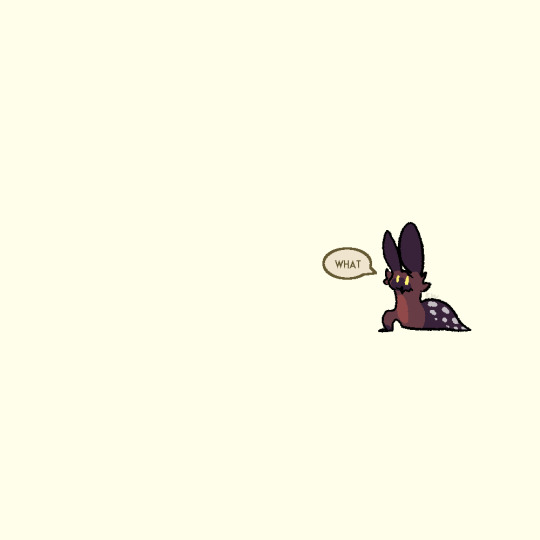
#rw voidlands#rwvl ask#rwvl fennel#OH MY GOD. ANON. THIS IS BEAUTIFUL#im so sorry she doesnt understand a word you said
20 notes
·
View notes
Text
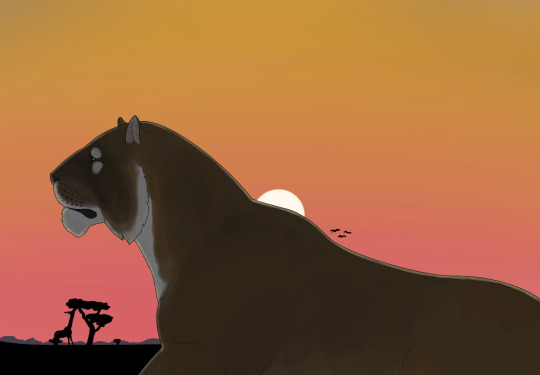
The sun is rising on the savannah. An old cat is resting amidst the grassland. He looks at the territory he held for almost six years at this point, much longer than almost any other male of his species. He’s a Machel’s lion (Leorex macheli), the apex predator of Aethiopia.
This new continent split from mainland Africa just before the interchange and was thus unaffected by it, with many lineages declining or extinct in Afrolaurasia still thriving here, east of the Great Rift Valley and the African Great Lakes.
Moving eastwards and exposed to the currents of the newly formed sea this continent’s climate is slowly but steadily changing. With the Asian monsoons now finally reaching the Eastern coast the first coastal forests are popping up on the edges of the Horn of Africa’s desert, and thanks to the rains brought from the West and strengthened by the equatorial currents the Lake Victoria rainforest was able to expand.

This rainforest is one of the most biodiverse areas of Earth, being so small in size but still hosting so many species. It’s inhabited by a wide array of wildlife. The largest are the ground dwelling primates, the pomorangs (Kampalapithecus chimpiskii), and the many forests antelopes of the genus Relictotragus, or kasolyas.; reptiles and birds alike inhabit the forest, with the most notable ones being pythons, water monitors, parrots and the junglefowl introduced in the Holocene; and a lineage extinct in the rest of the world is still found here, the Smutsiinae, with the still thriving East African giant pangolin (Catiosmutsia aethiopica).
The savannah doesn’t differ much from that of the Anectyocene, with cats, antelopes, dogs, perdvarks and gouebeervarks still being the most common sight there. The main difference here is the evolution of the tomeutheriid, and thus hyracoid, Zoshkoko (Tomeutherium ingens), the largest land animal of the continent, reaching 4 metres in height and rivaling the Pleistocene straight tusked elephant at around 14 tons in weight.
In the last million years there has also been a remarkable case of convergent evolution, with a population of laangvos adapting to a more frugivorous diet and establishing a symbiotic relationship with the Kei apple, eventually evolving into the shaggy wolf (Phytocyon keiophilus), uncannily similar to the maned wolves of South America.

#spec evo#spec bio#speculative evolution#speculative biology#worldbuilding#artwork#digital art#epigene period#future earth#future evolution
8 notes
·
View notes
Text
The Lion King (1994)

The Lion King is an animated Disney film released in 1994, directed by Roger Allers and Rob Minkoff. It tells the epic coming-of-age story of Simba, a young lion cub destined to become king of the Pride Lands, a vast African savanna. The film is set against the backdrop of a lush and vibrant landscape, rich with African-inspired imagery and culture.
In what ways does the film’s score situate the story with its narrative context?
Hans Zimmer's score for The Lion King plays a crucial role in situating the story within its narrative context. The use of African-inspired instrumentation, such as drums, flutes, and vocal chants, evokes the landscapes and cultures of the African savanna, where the story is set. This musical backdrop helps immerse the audience in the world of the film, enhancing the emotional impact of key moments and reinforcing the themes of family, identity, and the circle of life.
The presence of African languages, particularly Swahili and Zulu, plays a significant role in situating the context of the film within the African setting. Swahili, a widely spoken language in East Africa, including countries like Kenya, Tanzania, and Uganda, serves as a linguistic element that enhances the authenticity and cultural richness of the narrative. Zulu, a South Africna language, is present in the beginning of the classic song, "Circle of Life," provided by Lebo M., a South African composer.
youtube
2. How do songs use character performance to push cultural authenticity in the film's diegisis?
The songs in The Lion King not only advance the plot but also serve to deepen the film's cultural authenticity through character performance. For example, the character of Rafiki, voiced by Robert Guillaume, performs the song "Circle of Life" in a manner that draws from African musical traditions. Rafiki's energetic and spiritual rendition of the song reflects his role as a wise and mystical shaman within the Pride Lands, adding layers of cultural richness to the film's diegesis.
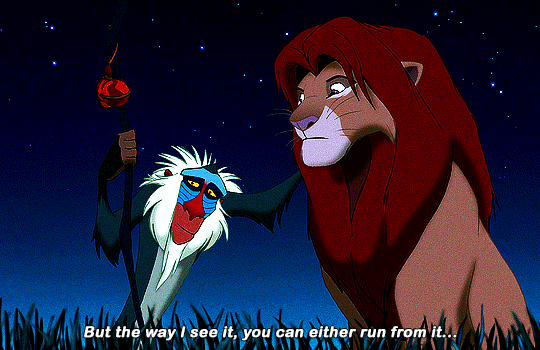
It's important to recognize the potential for misrepresentation, appropriation, and perpetuation of stereotypes. Robin Armstrong's exploration of musical colonization and appropriation in films like "Moana" provides a framework for understanding how colonialist perspectives can manifest in the portrayal of culture and identity in cinema.
One of the primary concerns with the colonialist lens is the tendency to exoticize or essentialize cultures that are depicted in film. In the case of The Lion King, while the film draws inspiration from African landscapes and cultures, there is a risk of reducing these diverse and complex traditions into simplistic or stereotypical portrayals. This can perpetuate harmful stereotypes and reinforce Western perspectives of Africa as a monolithic entity, rather than recognizing its diversity and richness.
Moreover, the colonialist lens may lead to the appropriation of cultural elements without proper understanding or respect for their significance. While the film's score and visual aesthetics draw from African musical traditions and imagery, there is a danger of these elements being co-opted for the purpose of entertainment without meaningful engagement with the cultures from which they originate.
3. In what ways does the film use musical “framing” to structure the score within familiarized styles?
The Lion King utilizes musical framing to structure its score within familiarized styles while incorporating African influences, creating a blend of familiarity and exoticism that appeals to a broad audience. This approach allows the film to maintain accessibility while still immersing viewers in the African setting and cultural context. Robin Armstrong's exploration of musical colonization and appropriation in films like "Moana" provides a lens through which to analyze how this framing functions within The Lion King.
One way in which the film employs musical framing is through the use of Broadway-inspired arrangements and melodies. Many of the songs in The Lion King, such as "I Just Can't Wait to Be King" and "Be Prepared," feature catchy tunes, dynamic orchestrations, and theatrical vocal performances characteristic of Broadway musicals. This familiarized style helps to engage viewers and draw them into the narrative, creating a sense of excitement and emotional resonance.
15 notes
·
View notes
Text
So even though the Tsavo Man-Eater story has clearly been mythologized and thoroughly corrupted by and for European and United States audiences, I think that I understand why you could still half-sincerely consider the infamous lion attacks as a sort of supernatural vengeance against British imperialism and the global expansion of industrial-scale resource extraction and finance capital.
Maybe, if only the victims had not been local African laborers and subjugated South Asian workers.
However, supernatural implications aside, all of this mass death in Africa -- death from both the Tsavo lion attacks and the mass death from famine following the 1890s rinderpest plague -- can still be attributed to European and US imperialism.
There is clear cause-and-effect, you can clearly see how death was caused by European industry, even if the agents enacting the killing happen to manifest as a Tsavo lion or a tsetse fly or a microscopic rinderpest virus.
The Tsavo Man-Eater story is such an interesting and eerily appropriate encapsulation of how European and US imperialism incite death, it’s almost too on-the-nose.
Radios, electric lighting, motor vehicles, convenient refrigerated food. And soon, in the near future, airplanes and motion pictures. In the 1890s, as the Gilded Age and Edwardian era brought wealth and “progress” to Europe and the United States, at a time when London and New York City and Berlin were experiencing a sort of golden age of prosperity, mass death swept across the rest of the planet.
And it wasn’t a coincidence.
---
The story was made famous across the planet after publication of the book The Man-Eaters of Tsavo (1907), authored by John Henry Patterson, the “hero” who killed the two voracious lion villains. Patterson was a British Army soldier, an adventurer, and a big-game hunter. His book later inspired multiple major Hollywood productions, including Killers of Kilimanjaro (1959) and The Ghost and the Darkness (1996). For those unfamiliar, British colonialist/imperialist military officers and engineers were constructing a railway bridge over the Tsavo River of Kenya as part of the major Kenya-Uganda Railway system to connect East African coastal ports with the interior of the continent to consolidate British imperial power at the height of the Scramble for Africa. Several thousand construction workers lived near the site in camps, and the British imported many workers from colonial territory in India and South Asia. The Uganda Railway contracted Patterson to oversee the construction of the bridge. Patterson was also the one who oversaw the response to the many lion attacks. (After service as an officer in the First World War, Patterson would become known, in Bi/bi Netan/yahu’s words, as “the godfather of the I/sraeli army.”)
Between March 1898 and December 1898, at least 28 workers were attacked and killed by lions. Probably two especially-cunning male lions, without manes. In his reports and book, Patterson himself claimed that at least 135 men were killed by these lions in 1898. (The 28-death estimate was reached by isotopic analysis of presumed human signatures in the preserved remains of the lions, but this estimate would be an approximation of how many humans were fully consumed and doesn’t account for humans that might otherwise have been killed but not entirely consumed.) We don’t know how many people were killed during this period, because many “missing” workers may have absconded, left the site. Records are also unreliable probably because British officers didn’t care too much for the well-being of African and South Asian workers. In December 1898, Patterson finally shot and killed the two maneless lions now on display at the esteemed Field Museum of Natural History in Chicago.
The British Empire moves in to consolidate power, to conquer Africa, and even in these initial stages of building railways and roadways, the empire sacrifices the lives of African and South Asian laborers.
---
Why would the lions specialize in hunting humans?
Another way to phrase the question: How can human injustice and institutionalized violence contribute to death from “natural” causes?
In Tsavo, specifically, it’s been proposed that the centuries of slave-trading in the Indian Ocean contributed to the lions’ preference for hunting humans. The local area around the Tsavo bridge/crossing was traversed by slave-trading caravans en route eastward to Zanzibar. For years, bodies of those enslaved people who didn’t survive the caravan were probably left behind in the Tsavo landscape, allowing -- in this proposal -- the lions to get used to the taste of humans. Hard to determine for sure.
But there’s more violence at work.
Italian colonialists brought imported cattle to East Africa in 1887 to feed their forces in war against Somalia.
It is thought that these cattle were the source of the rinderpest epidemic/epizootic plague which devastated Africa throughout the 1890s.
Rinderpest doesn’t just affect domesticated cattle and its attendant “modernized” agricultural industries. The 1890s rinderpest plague also devastated native ungulates, including gazelles, antelope, and wildebeest.
So millions of domesticated cattle died, leading to mass starvation across the African continent. And millions of native African ungulates died, leading to ecological upheaval.
In the 1890s, it is estimated that one-third of Ethiopian people and two-thirds of the Maasai people died due to this rinderpest-plague-induced famine.
Then, alongside this famine, global drought emerged in response to an El Nino event in 1897 (unfortunately quickly followed by more El Nino events in 1899 and 1902). The drought pummeled sub-Saharan Africa.
Because the rinderpest plague killed herds of native ungulates simultaneously as the famine killed humans, former grazing grounds in grasslands were colonized by thornbush. And thornbush is perfect habitat for tsetse flies.
These tsetse flies then spread sleeping sickness to humans, leading to more plague, misery, mass death.
The thornbush expansion also functions as part of a feedback loop: Ungulate herds diminsh, so thornbush expands, and the “new” thornbush habitat is undesirable for ungulate grazing, so the herds don’t return.
The mass death of cattle and native ungulates in the mid and late 1890s has also been proposed by some to be part of the reason why Tsavo’s lions resorted to apparently specialize in hunting and killing humans in the absences of ungulates to feed upon.
---
In the 1890s, the famines and plagues in sub-Saharan Africa coincided with the Third Plague Pandemic devastating Asia; catastrophic food shortages in Indonesia, the Philippines, and mainland Southeast Asia; smallpox epidemics in Brazil; cholera epidemics in China. Millions of people, from Korea across Asia and Africa to the ranches and mines of Latin America, died from famine alone.
Meanwhile, aristocrats played in parlors of London and New York, gazing from balconies upon new factories, new electric lights, new motor vehicles, new radios, new copper wiring, new technologies, and a new century.
Fin de siecle, indeed. How’d they pay for it? How did civilization purchase this prosperity?
Blame it on the lions, a tsetse fly, a rinderpest virus, “natural” El Nino events, whatever. Misery at this scale doesn’t just happen.
170 notes
·
View notes
Note
Hi Shiba, its been a while (🎧anon btw). I hope you gave been doing awesome!!!! I wanted to ask a question, since im really want to write a fic about Leona's SO meeting his brother and his wife, and I really dont want to be disrespectful (and i dont think google is giving me accurate answers). So I wanted to ask what are some ways to respectfully address elders in East Africa (since I believe thats where the Lion King is set, because Swahili is the main language used and etc.). Please dont answer if my question was in any way rude or inconsiderate, and I hope you have an awesome day♥️
IT'S BEEN SO LONG
I'VE BEEN WONDERING ABOUT YOU DARLIN!
What makes this ask even better is that you sent it during black history month!
In Africa (and with African diaspora), we're all aware that respect of elders is EXTREMELY important. In many cultures, mainly in Africa, you kneel, bow, or prostate yourself before elders to show respect whilst you greet them.
In Tanzania and Kenya, there is a verbal greeting reserved specifically for elders, according to my research.
When addressing an elder, you would say, "Shikamoo" meaning, "I give you respect."
This would be responded to with, "Marahaba" which means, "I accept your respect."
Now if there's anyone who might know whether or not this is TRULY accurate, I'd love to receive this information. Especially from someone who may speak fluent Swahili or at least more than I do.

#swahili#kenya#tanzania#twst#twisted wonderland#savanaclaw#leona kingscholar#twst falena#falena kingscholar#twst cheka#cheka kingscholar#afterglow savanna#sunset savanna#🎧 anon#africa#east africa
14 notes
·
View notes